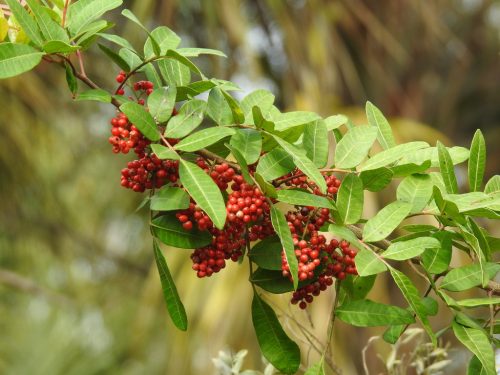What’s going on?
Spreading over 700,000 acres in south and central Florida, the Brazilian peppertree is one of the most aggressive and widespread invasive plants in the state. Its multi-stemmed branches cross to form a dense canopy that shades out native plants in natural and developed areas. Two types of Brazilian peppertrees from different areas of Brazil were introduced in Florida, resulting in hybridized trees that have higher growth rates. This further increases the peppertree’s range.
Why it matters.
According to The Nature Conservancy, nearly $45 million in state and federal funding is spent in Florida per year to manage invasive plants in natural areas and waters. The pervasiveness of invasive plants like the Brazilian peppertree can negatively alter the habitats of native plants, which decreases biodiversity, orthe variety of plants and animals in an area. Decreasing biodiversity has widespread economic and environmental impacts throughout the state, including increased risk of invasions by non-native species, and increased habitat degradation, both of which impact Florida’s tourism-based economy. That’s why managing invasive species like the Brazilian peppertree is important and requires resources and funding directed to it.
How to identify.

- An evergreen shrub or tree from 3 to 10 meters tall with multi-stemmed trunks and branches that arch and cross, forming tangled masses.
- Leaves are alternate pinnate with narrowly winged green finely hairy axis. Leaves also smell peppery or like turpentine when crushed.
- Flowers have five white petals.
- Berries are small, bright red and spherical.
What you can do.
If you have Brazilian peppertree on your property:
- Remove seedlings by hand pulling or herbicide treatment.
- Use cut stump treatment for large multi-stem shrubs: Use a saw to cut the trunk as close to the ground as possible and apply an herbicide containing the active ingredient glyphosate or triclopyr within five minutes to the living tissue inside the bark of the stump.
- Plant comparable native shrub species such as varnish leaf, elderberry, or seagrape.
Information from UF/IFAS Center for Aquatic and Invasive Plants, Everglades Cooperative Invasive Species Management Area, UF/IFAS Ask IFAS, The Nature Conservancy, National Parks Service, Florida Atlantic University, and Florida Fish and Wildlife Conservation Commission.